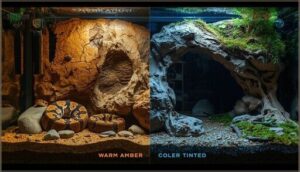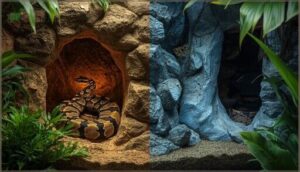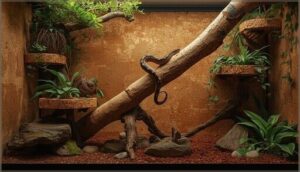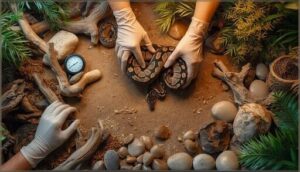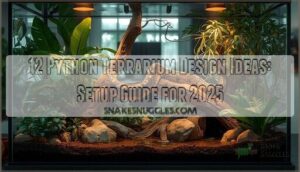This site is supported by our readers. We may earn a commission, at no cost to you, if you purchase through links.

Your ball python’s enclosure isn’t just a container—it’s a microhabitat that directly influences your snake’s stress levels, activity patterns, and overall health. Many keepers focus exclusively on temperature and humidity while overlooking how strategic decoration choices can transform a sterile box into an environment that encourages natural behaviors like climbing, thermoregulating, and exploring.
The difference between a minimally decorated tank and a thoughtfully enriched one shows up in your snake’s confidence, feeding response, and willingness to move beyond a single hiding spot.
Getting ball python tank decoration tips right means understanding which materials pose hidden dangers, how to position elements within thermal zones, and which features deliver both visual appeal and genuine behavioral benefits.
Table Of Contents
Key Takeaways
- Your ball python’s enclosure should replicate its natural savannah habitat with a thermal gradient of 75°F to 90°F, humidity around 50-60%, and multiple hides positioned on both warm and cool sides to reduce stress and support natural thermoregulation.
- Ball pythons are semi-arboreal climbers who benefit from horizontal branches positioned 12-18 inches high and cork flats that provide both climbing enrichment and secure retreats, with peak activity occurring during morning to midday hours.
- Water dish placement directly affects humidity control—positioning on the cool side reduces evaporation by up to 40% and bacterial growth, while warm side placement boosts local humidity by 10-20% to aid shedding cycles.
- Regular maintenance every 1-3 months using reptile-safe disinfectants like F10SC or 10% bleach solution prevents health risks, while rotating decorations every 3-4 months maintains environmental enrichment without overwhelming your snake with unfamiliar territory.
Essential Elements for Ball Python Tank Decor
Setting up a ball python’s tank isn’t just about adding a few decorations and calling it done. Your snake needs specific elements that work together to support its physical health and mental well-being.
Let’s walk through the three core principles that should guide every decorating decision you make.
Mimicking Natural Habitats
In the wild, ball pythons thrive in savannahs and forest edges with dense ground cover, loose soil, and natural shelters like termite mounds.
Your enclosure should replicate this environment through natural substrates such as coconut fiber, a proper thermal gradient from 75°F to 90°F, and humidity levels around 50-60%.
Incorporate climbing structures and multiple hides to encourage natural climbing behavior and habitat enrichment, creating environmental enrichment that bolsters their instinctive needs. Solid-sided panels can also help reduce stress and promote a sense of security.
Choosing Safe and Non-Toxic Materials
Once you’ve nailed the habitat setup, material safety becomes your top priority. Cedarwood and pine release toxic oils that damage your snake’s respiratory system and liver, so stick with safe wood types like driftwood and cork bark instead.
For substrate options, choose coconut husk or cypress mulch over unsafe alternatives. Reptile-safe plastics and decor items labeled for herps eliminate chemical residue risks. Always prep natural materials by sanitizing before adding naturalistic background elements or reptile accessories.
Providing the right UVB lighting is also key for vitamin D3 synthesis.
Balancing Functionality and Aesthetics
A well-decorated enclosure doesn’t mean sacrificing function for looks. Ball python terrarium decorations should serve dual purposes—providing functional enrichment while delivering visual appeal that boosts owner satisfaction.
You’ll find that artificial foliage and terrarium background elements can create a natural snake environment without compromising safety balance.
Current engagement trends show that thoughtful terrarium decoration ideas combining aesthetics with purpose lead to healthier, more active snakes.
Hides and Shelter Options
Your ball python needs at least two hides to feel secure—one on the warm side and one on the cool side of the enclosure. These shelters aren’t just decorative additions; they’re essential for reducing stress and encouraging natural behavior.
Ball pythons need two hides—one warm, one cool—not for decoration, but to reduce stress and encourage natural behavior
Let’s look at how to choose the right hides and create spaces where your snake can retreat with confidence.
Selecting Warm and Cool Side Hides
Choosing the right hides isn’t just about picking something cute—it’s about creating genuine security. Your ball python needs at least two hiding spots: one on the warm end (88-92°F) and one on the cool end (75-80°F).
Here’s what makes an effective hide:
- Snug fit where sides gently touch your snake’s body
- Non-toxic hide material like cork bark or smooth resin
- Strategic placement within each temperature zone
- Regular temperature monitoring with digital thermometers
DIY and Commercial Hide Ideas
Your options span from budget-friendly DIY projects to ready-made commercial solutions, each bringing distinct advantages. Repurposed plastic containers, like oil pans or litter boxes, offer economical custom hides under $10-$20, while commercial options from brands like Exo Terra and Zilla range $7-$40 with enhanced commercial durability and heat conductivity.
| Approach | Cost Range | Key Advantage |
|---|---|---|
| DIY (foam/plaster) | $10-$20 | Customization & enrichment accessories |
| Commercial hides | $7-$40 | Proven behavioral preferences & longevity |
Prioritize DIY safety through low-VOC materials and aquarium-safe sealants, ensuring hiding places support your snake’s thermal regulation needs.
Creating Secure and Private Spaces
Beyond physical structure, your ball python’s hiding places must satisfy their deep-rooted need for thigmototaxis comfort—that reassuring contact against their body’s sides. Strategic hide placement on both thermal zones lets your snake regulate temperature without sacrificing security, directly reducing snake stress indicators.
Snug, properly sized hiding spots prevent escape attempts while supporting behavioral monitoring, transforming environmental enrichment from optional luxury into fundamental welfare necessity for your snake environment.
Climbing and Enrichment Features
Ball pythons aren’t strictly ground-dwellers—they’re semi-arboreal, which means they naturally climb and explore elevated surfaces in the wild. Adding climbing features to your tank activates this instinct, giving your snake physical exercise and mental stimulation.
Let’s look at practical ways to incorporate branches, platforms, and other structures that encourage this natural behavior while keeping your python safe.
Incorporating Branches and Cork Flats
Ball python enclosure setup benefits greatly from climbing opportunities that mirror their semi-arboreal nature. Thick branches, positioned horizontally or at gentle inclines around 12-18 inches high, offer climbing safety while encouraging snake climbing behavior.
Cork flats work double-duty as textured platforms and secure retreats, enhancing behavioral enrichment. Proper branch selection and cork placement transform static tanks into active habitats.
Decor maintenance—cleaning, inspecting, and securing items—remains essential for injury prevention.
Artificial Vs. Natural Climbing Structures
When deciding between climbing structures, weigh material durability and safety concerns carefully. Artificial plants and branches offer easy hygiene maintenance and cost-effective solutions, while natural options deliver exceptional aesthetic realism with a naturalistic background.
Resin-based climbing branches reduce injury risks through smooth surfaces, whereas authentic wood provides greater tactile enrichment for snake climbing despite requiring frequent inspection.
Your choice ultimately balances practicality against environmental authenticity.
Encouraging Natural Climbing Behavior
You’ll notice your ball python becomes most active with climbing structures during morning to midday hours—that’s when their natural exploratory drive peaks. Position climbing opportunities strategically to match this behavior pattern:
- Secure sturdy branches near basking zones for thermoregulatory benefits
- Offer varied heights and textures to stimulate natural snake enrichment
- Monitor climbing activity levels, especially in juveniles who climb more frequently
- Adjust arboreal enrichment seasonally to mirror wild activity patterns
Observing these climbing decor safety guidelines transforms passive housing into active environmental enrichment.
Water Features and Humidity Control
Water features play a critical role in your ball python’s health, serving dual purposes for hydration and humidity regulation. Getting the water dish right isn’t just about filling a bowl—it’s about understanding how placement and design affect your snake’s ability to drink, soak, and maintain proper shed cycles.
Let’s examine the key considerations for water features that support both behavioral needs and environmental stability.
Choosing The Right Water Dish
Your ball python’s water dish isn’t just about hydration—it’s a critical piece of habitat hardware. Selecting the right one means weighing material safety, size considerations, and cleaning frequency to keep fresh drinking water available. Heavy water dishes made from ceramic or stone prevent tipping, while their surface area directly impacts humidity effects.
Here’s how water dish requirements for snakes break down:
| Factor | Baby/Juvenile | Adult |
|---|---|---|
| Volume | ~8 oz | 16+ oz |
| Material | Ceramic, non-porous | Heavy ceramic, stone |
| Cleaning | Every 2-3 days | Weekly minimum |
| Depth | 50-75% snake girth | 50-75% snake girth |
Non-porous materials like ceramic resist bacteria buildup and simplify maintenance, ensuring your snake always has access to clean water without chemical leaching risks.
Placement for Drinking and Soaking
Where you position the water dish in your snake enclosure directly impacts humidity levels and your snake’s comfort. Most keepers favor cool side placement to reduce evaporation by up to 40%, while warm side positioning boosts local humidity by 10-20%—helpful during shedding.
Consider these proven approaches:
- Cool side reduces bacterial growth and refill frequency
- Warm side creates natural humidity through evaporation
- Central placement or dual soaking bowls offer balanced access
Proper positioning aids both hydration and reptile habitat health.
Decorative Solutions for Humidity Maintenance
Beyond water placement, you can turn functional humidity tools into attractive elements of your setup. A humid hide filled with moist sphagnum moss doubles as a natural-looking retreat while maintaining localized humidity near 70%.
Cover 80-90% of screen tops with decorative panels to reduce airflow, and mix live plants into moisture-retaining substrate for transpiration that naturally boosts humidity levels without constant misting.
Maintenance and Safety Considerations
Setting up your ball python’s enclosure is only half the battle—keeping it safe and stimulating requires ongoing attention. Regular maintenance prevents health risks while ensuring decorations continue to serve their purpose.
Here’s how to maintain a clean, hazard-free environment that keeps your snake engaged and thriving.
Cleaning and Sanitizing Decor Items
To protect your snake’s health, start cleaning and sanitizing decor items every one to three months. Scrub porous materials like wood with hot soapy water, then soak them in a reptile-safe disinfectant such as F10SC or a 10% bleach solution for 10–15 minutes.
Rinsing thoroughly prevents cross-contamination and chemical exposure. Air-dry everything completely before returning items to the tank, supporting long-term reptile health.
Inspecting for Sharp Edges and Hazards
Once your decor is clean, run your hand over every surface to catch snags that could harm your snake. Edge identification starts with tactile checks—smooth rough spots with sandpaper and watch for material degradation like cracks or splinters. Regular inspection frequency matters for injury prevention, especially around hiding spots where entrapment risks hide. Your attention to these safety considerations directly aids snake health in their habitat.
- Feel all surfaces for protruding sharp points
- Sand down rough edges on wood and synthetics
- Check for holes where your snake could get stuck
- Inspect after long-term use for wear and breakage
- Examine water dishes for cracks or damage
Rotating and Updating Decorations for Enrichment
Changing your enclosure setup every three to four months prevents behavioral stagnation while maintaining familiar territory markers. Rotation frequency depends on your snake’s response—seasonal decor like new branches or moss accents provides environmental enrichment without overwhelming stress.
Make gradual changes, swapping climbing structures or enrichment accessories between hygiene protocols. This approach to snake enrichment strategies keeps decor items fresh, creating a stimulating environment that encourages natural exploration and fosters long-term wellbeing.
Frequently Asked Questions (FAQs)
How often should I replace live plants?
Most ball python owners wonder if live plants truly thrive long-term in snake habitats. Plant replacement frequency generally ranges from six to eight months, though bioactive benefits and proper humidity extend plant health indicators considerably beyond traditional terrarium setup expectations.
Can ball pythons share tank decorations with other snakes?
Sharing terrarium setup items between snakes risks disease transmission and cohabitation stress. Each snake enclosure requires its own decor to guarantee material safety, proper space allocation, and behavioral enrichment without compromising snake safety or habitat hygiene.
What lighting colors do ball pythons prefer?
Studies show that improper lighting can disrupt circadian schedules and feeding patterns in captive reptiles.
Your ball python thrives with natural daylight mimicry using white LED or full-spectrum lighting, avoiding red light harm and blue light effects that cause stress.
Do ball pythons recognize their tank decorations?
Your ball python likely recognizes tank decorations through scent-based recognition and tactile exploration rather than sight.
They develop spatial memory of hides and branches, showing decoration preferences that reduce stress while creating a stimulating environment.
Should decorations change with seasonal temperature variations?
When your room’s temperature dips in winter, strategic enrichment adjustments help maintain proper temperature gradients and humidity levels. Think moisture-retentive substrates near warm hides and repositioned branches encouraging activity in heated zones year-round.
Conclusion
Think of your ball python’s enclosure as a living canvas where every element fulfills a purpose beyond appearance. Applying these ball python tank decoration tips transforms a functional box into a space that actively bolsters natural behaviors, reduces stress, and promotes long-term health.
When you prioritize safety alongside enrichment, your snake doesn’t just survive—it demonstrates the confident, exploratory behaviors that signal genuine thriving in captivity.
- https://reptifiles.com/
- https://www.reddit.com/r/HerpHomes/comments/oaj182/what_materials_are_safe_for_reptiles/
- https://community.morphmarket.com/t/diy-hides-for-bp/28823
- https://www.facebook.com/groups/everythingballpythons/posts/1775456669762851/
- https://talis-us.com/blogs/news/ball-python-hides-a-guide-to-providing-the-perfect-hideouts

